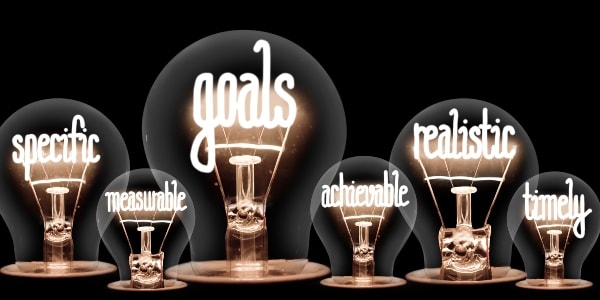Speaking to evidence-based best practices of establishing SMART goals and their links to successful recovery of individuals with addictions and mental health issues.
Goals and Objectives: The difference between the two and utilizing both in treatment plans.
While the terms are often used interchangeably, goals and objectives are different. In addictions and mental health treatment, both are used in the pursuit of recovery with goal setting the bigger picture while objectives set the more measurable milestones that show one is getting there.
| Goal | Objective | |
| Definition | The broad, overall intention to achieve | The specific, measurable actions that are taken to accomplish the goal/target |
| Examples | Stop using alcohol to cope with negative feelings
Recognize individual triggers and associated emotions
Improve physical health |
To take a 5 minute walk outdoors and call a friend when negative feelings arise
Keep a daily log for 2 weeks that tracks events and associated emotions
Walk for 30 minutes after dinner 5 nights per week |
| Insight | Intangible; ‘big picture’ | Measurable; Specific Target |
| Time Frame | Longer; no end date often | Shorter, guided, dated |
| Goals & Objectives Working Together | “By taking my medication daily (objective), I can relieve my depressive feelings (goal)” |
“Committing to writing in a daily journal (objective) for a month will build me a list of my triggers that lead to the negative feelings I want to address (goals)” |
| Tracking | Always moving forward to accomplish goal – loose but always present |
Specifically tracked tasks assigned; a measurable ‘plan’ to follow |
SMART goals are a blending of goals and objectives that allow the clinician and client to collaboratively Create, Apply, Review, and Evaluate (the CARE Strategy) the individualized treatment plan.
S – Specific – be clear and defined in what is to be accomplished.
M – Measurable – ‘attend group sessions’ is not measurable but agreeing to attend ‘5 group sessions weekly’ is.
A – Actionable – can a client attend 5 group sessions in person weekly if they have just started a new job or is that’s too much to commit to at current levels of anxiety, etc?
R – Realistic – are client expectations and ‘goals’ realistic? Often a client will present with an all or nothing approach.
T – Timely – are the timeframes realistic? Does client have events coming up that present specific challenges (surgery, new job, no transportation, daycare requirements, pending weather, financial issues)?
Not SMART: Attend group sessions regularly and participate occasionally until you feel stronger in communicating your feelings consistently.
SMART: Starting Tuesday, April 11, attend 3 group sessions each week and participate verbally in discussion once at each meeting in April, twice at each meeting in May and June, and initiate a topic once in a June session.
The more defined, the clearer the map to follow to reach one’s destination.
Client records and treatment plans should contain the most up-to-date information and progress regarding a client’s SMART goals. With this information readily available, note writing and reporting becomes faster, more efficient, and more valuable for everyone.







